
- Insights
- Cryptocurrencies
- Stocks
- White Papers
- Industry
- Geography
- Insights
- Cryptocurrencies
- Stocks
- White Papers
- Industry
- Geography


As AI and ML are dominating almost all sectors around us, the future of cybersecurity is bright. For long years, organizations have obtained discrete security products, like threat detection, virtual private networks, secure email gateways, and endpoint protection, among others.
This cybersecurity sprawl of single-function products is becoming a source of serious stress for IT and security teams that are now confronted with complex and fragmented security postures. Making an effort to secure their data and IT resources, IT and security operations come across the restriction of trying to stitch together a patchwork of products. These siloed solutions can't communicate, coalesce their data and functionally share policies, logs, or remote telemetry data.
Digital transformation is changing the face of our world. Not just 1's and 0's, it's affecting our physical world, too. Technology and our physical world are now not distinguishable. Organizations should move beyond technology upliftment and advanced workflows. To preserve IT resources and customer data, there is a need for technology that eliminate vulnerable security gaps and exploitable holes. It needed to spend lesser time on manual security configurations and processes and we should dedicate more time to creating exceptional user experiences that drive personalization to transform business outcomes.
Putting an effort to manage dozens of independent security tools comes with substantial operations overhead. Technology complexity is navigating security operations to replace, by consolidation, the number of dissimilar vendor products they deploy.
Compounding cybersecurity sprawl is organizations voraciously expanding digital footprints. A large number of new attack surfaces are being revealed with the explosive adoption of numerous clouds, perform from anywhere, IoT devices, and mobile users. Organizations are compelled to abandon conventional corporate perimeters, exchanging them with distributed cybersecurity that is globally managed and controlled with multi-functional platforms. A unified cybersecurity defense is transforming a business imperative to remove exploitable security weak points caused by disparate security products and tools.
Punctuation and the space between words serve a clear understanding of the meaning of a sentence and the intent of the author. In the sphere of cybersecurity forensics, cohesion and visibility are needed to identify anomalies, risks, and vulnerabilities that bad actors can exploit. Hackers have multiple tactics in their efforts to exploit technology flaws and human vulnerabilities. Cybersecurity enabled by artificial intelligence (AI) and machine learning (ML) can help security teams differentiate between normal and anomalous activity, while analytics offers a deep understanding of the hacker's intentions.
Cyberattacks can include multiple stages that together comprise an attack chain. Attacks that are detected at the point of origin can be immediately killed to prevent data loss and malware that can spread across the network. Just as in our physical world, cyberattacks contain traceable evidence. Analyzing a cyberattack chain of evidence requires deep intelligence, visibility, and insights across all attack surfaces. Insightful data that have been coalesced and analyzed from multiple network entry points and across other internal attack surfaces enable investigations to rapidly prevent and mitigate attacks.
The finest way to terminate security skeletons skulking in an organization's proverbial closet is to unify cybersecurity intelligence. This keeps the potential to deliver considerable forensic clarity by offering a single dashboard view of all attack vectors and surfaces. That single-view perspective can succinctly align the cross-connections of multiple natively integrated security functions with extensive contextual data. Applying sophisticated analytics and threat intelligence gives a view of the full context of an attack, with complete visibility across the entire chain of events.
Not only do cybersecurity solutions need to be more united, but it is also required for them to be extensible to support an open framework for interoperability. This offers them to share information with management platforms like security orchestration, automation and response (SOAR), and security, information, and event management (SIEM).
Security automation permits IT and security operations to focus on strategic projects without getting bogged down with the processes underpinning their work. This makes them accomplish more and with considerable accuracy. Automating processes reduces manual steps to reduce the time required to obtain data from multiple attack vectors and attack surfaces for analysis. This can eliminate the time and effort collecting, coalescing, and analyzing cyberattacks, from hours, or even days, to just minutes.
